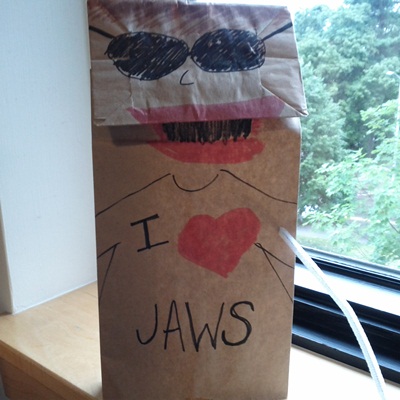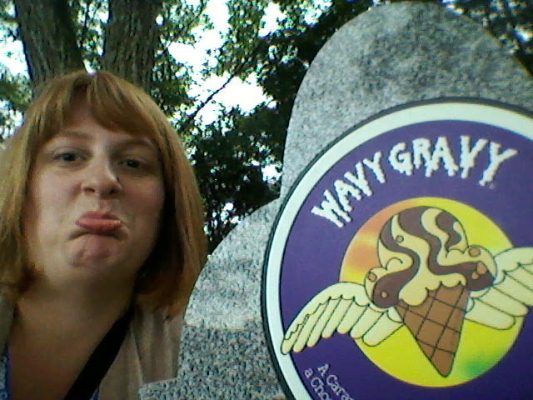In my request for travel support to attend the Association of College & Research Libraries Immersion ’12 Teacher Track Program, I pledged to blog about my participation in Immersion. To read more about my Immersion experience, check out my posts tagged immersion or my Immersion tweets.
Puppet. Student-centered. Mind blown.
The sparse nature of Wednesday’s notes belies the fullness of the day’s schedule: Connecting Outcomes and Content, Student-Centered Learning, Leadership for Instructional Change, Teaching Presentations w/Faculty, and an off-campus social event.
The puppet is this guy:
I created him during an activity in which we crafted puppets representing our students, and he represents a student with accessibility needs. I had fun creating the puppet and hearing others talk about who they chose to represent. This underscored my belief that the learning styles we discussed on Tuesday are best used as a reference for designing learning opportunities that are appealing to all, rather than labels to be applied and taught “to” (according to the Kolb Learning Style Inventory we took the day before, I am an Assimilator and am not supposed to like such things). FWIW, I prefer universal design, not learning styles, as an instructional framework.
The mind-blowing part of the day was an activity we did as part of our discussion on student-centered learning. We were provided with a list of seven principles to guide the instructor in developing a learner-centered classroom:
- Teachers do learning tasks less.
- Assign to students some of the tasks of organizing the content, giving examples, summarizing discussions, solving problems, and drawing diagrams, charts, and graphs.
- Teachers do less telling; students do more discovering.
- Give a quiz on your syllabus and policies without going over it first. Let students discover information in assigned readings without presenting it first or summarizing it later.
- Teachers do more design work.
- Design activities and assignments that move students to new skill levels, motivate engagement in the course content by doing the work of practitioners in the discipline, and that develop self-awareness of their learning of the content.
- Faculty do more modeling.
- Demonstrate how a skilled learner (the teacher) continues to learn. Show them drafts of your articles, notes on your own reading in professional journals; talk aloud as you solve a problem, thereby revealing and modeling your thinking process.
- Faculty do more to get students learning from and with each other.
- Create work for small groups to do in class.
- Faculty work to create climates for learning.
- Create a climate that promotes interaction, autonomy, and responsibility (more in chapter five).
- Faculty do more with feedback.
- In addition to assigning grades, use other means of providing frequent feedback (more in chapter six).
Originally published in Maryellen Weimer’s Learner-Centered Teaching : Five Key Changes to Practice , I snagged the list from this review.
Having been given the list, we were then asked to identify how often/to what extent our instruction reflected these principles by assigning a numerical rating to each statement (0 for never/not at all, 10 for always/fully ). Each statement was then read aloud, and we responded by positioning ourselves in the physical space according to our response.
Here’s where the “mind blown” part comes in. In response to the first statement- “teachers do learning tasks less”- I headed over to the two-ish part of the room, and with a couple of exceptions, that’s pretty much where I stayed. I was surprised and a little embarassed. I think of myself as very student-centered in my professional orientation- we are not our users!– but my classroom is not learner-centered. At all. The kinesthetic nature of the activity really hammered home that there is a disconnect between what I want to do and what I am actually doing. Immersion emphasizes the idea of becoming a more authentic teacher. In order to do that, I need to stop worrying about what my instruction “looks” like as compared to that of the other librarians with whom I teach (“will the instructors complain if I don’t do the demo so-and-so does?”) and do less telling so students can do more discovering. The changes in our approach to EN102 instruction are going to make this easier, so I’m excited about that.
We did our teaching presentations on Wednesday, but I’m going to do a separate post about that. We ended the day with barbecue, following a trip to Ben & Jerry’s Waterbury Factory, where I mourned the loss of a friend:
Requiescat in pace, Wavy Gravy.

